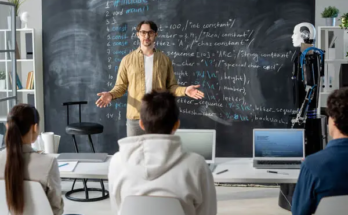Introduction

In today’s fast-paced, technology-driven world, intergenerational learning is a concept gaining momentum. But what exactly does it mean? Intergenerational learning involves the exchange of knowledge, skills, and experiences between people of different generations, particularly between students and older adults. This learning dynamic not only enriches students’ education but also offers valuable benefits to older generations. Let’s explore the numerous advantages of intergenerational learning and how it can bridge the gap between age groups, fostering a more inclusive, enriching educational experience.
What is Intergenerational Learning?
Intergenerational learning is a process where individuals from different age groups such as students and older adults—share knowledge, experiences, and skills in a collaborative learning environment.
The Importance of Cross-Generational Exchange
The foundation of intergenerational learning lies in the idea that wisdom, experiences, and skills are passed down from older generations to younger ones. Students can gain practical knowledge and life lessons, while older adults can benefit from the fresh perspectives of youth.
The Growing Trend of Intergenerational Programs
In recent years, there has been a rise in intergenerational programs, where schools, universities, and community centers facilitate interactions between students and older adults. These programs are designed to break down generational barriers and foster mutual respect and understanding.
Benefits for Students
Intergenerational learning provides an array of advantages for students, impacting everything from personal development to academic performance.
Enhanced Emotional Intelligence
By interacting with older adults, students develop emotional intelligence. Learning to empathize with and understand the experiences of older generations helps students improve their communication and social skills.
Building Stronger Social Skills
Students who engage in intergenerational learning activities learn how to interact with people from different backgrounds, cultures, and age groups, making them more adaptable and skilled in navigating diverse social settings.
The Academic Benefits of Intergenerational Learning
It’s not just the emotional and social aspects that intergenerational learning benefits—academic outcomes can also improve as a result of these interactions.
Exposure to Practical Knowledge
Older adults often bring with them a wealth of life experiences that are not typically covered in textbooks. This real-world knowledge can make learning more relevant and applicable for students, bridging the gap between theory and practice.
Mentorship and Guidance
Older adults can serve as mentors, offering guidance, advice, and support in both academic and personal areas. Having someone to look up to, who has navigated life’s challenges, can help students gain clarity and confidence in their educational journey.
How Older Adults Benefit from Intergenerational Learning
While students certainly gain a lot from intergenerational learning, older adults also enjoy several advantages from these exchanges.
Increased Social Engagement
Older adults, particularly those who may feel isolated, experience greater social engagement through interactions with students. Regularly participating in intergenerational activities can combat loneliness and help seniors build social connections.
Mental Stimulation and Cognitive Benefits
Engaging with younger generations can help keep older adults mentally sharp. Discussing modern ideas, learning new technologies, or teaching a new generation can help stimulate cognitive function and keep the mind active.
Strengthening Community Bonds
Intergenerational learning is not just about personal benefits—it also strengthens community ties by fostering connections across generations.
Fostering Mutual Respect
Through regular interactions, students and older adults develop a mutual understanding and respect for each other’s experiences and perspectives. This respect helps bridge generational gaps and promotes social cohesion.
Creating a More Inclusive Society
Intergenerational learning programs create spaces where people of all ages can come together, learn from one another, and collaborate. This inclusivity helps build stronger, more resilient communities.
Also Read : Creative Ways for Students to Earn Money Online in 2024
Intergenerational Learning in Action
There are many ways intergenerational learning can be implemented, from formal classroom settings to community-based activities.
Classroom-Based Intergenerational Programs
Some schools have integrated intergenerational learning into their curriculum by inviting older adults to share their knowledge with students. These programs can range from storytelling sessions to practical workshops in subjects like history, art, or life skills.
Community Engagement Activities
Outside the classroom, intergenerational programs are increasingly popular in community centers, senior living facilities, and local organizations. Students might volunteer their time to help seniors with tasks, or they may collaborate with older adults on creative projects like gardening, cooking, or art.
Overcoming Generational Stereotypes
A significant advantage of intergenerational learning is the opportunity to challenge stereotypes and misconceptions that exist between generations.
Reducing Age-Related Stereotypes
By engaging directly with older adults, students begin to see them as individuals with rich experiences rather than adhering to stereotypes about aging. Similarly, older adults gain a better understanding of the aspirations and challenges of young people.
Promoting Intergenerational Respect
In addition to breaking stereotypes, intergenerational learning fosters mutual respect between generations. Students recognize the value of older adults’ contributions, and older adults appreciate the energy, creativity, and new ideas that younger generations bring.
The Role of Technology in Intergenerational Learning
Technology can play an essential role in enhancing intergenerational learning by providing platforms for interaction and knowledge-sharing.
Virtual Learning Opportunities
Through online platforms, students and older adults can connect for virtual classes, discussions, and even collaborative projects. Technology also allows seniors to share their stories and wisdom with younger generations, making learning more accessible.
Bridging the Digital Divide
While older adults may not always be as familiar with technology, intergenerational programs offer opportunities for younger generations to teach them how to use digital tools. This can help reduce the digital divide, making both generations more tech-savvy.
The Future of Intergenerational Learning
As society continues to evolve, the importance of intergenerational learning is only expected to grow. It provides a unique solution to challenges such as social isolation, generational gaps, and the need for lifelong learning.
Expanding Intergenerational Programs
Governments and educational institutions are increasingly recognizing the benefits of intergenerational learning and are expanding programs to encourage more participation. With the aging population on the rise, these programs will become even more critical in ensuring continued social and educational engagement.
Lifelong Learning for All Ages
Intergenerational learning supports the concept of lifelong learning, which suggests that learning should continue throughout one’s life. By fostering collaboration between generations, these programs create opportunities for both students and older adults to keep learning, growing, and adapting.
Conclusion
Intergenerational learning is a powerful tool for promoting educational, social, and emotional development for people of all ages. By creating spaces where students and older adults can share knowledge, experiences, and wisdom, we strengthen communities, combat stereotypes, and foster mutual respect. The integration of these programs into our schools, communities, and workplaces can help bridge generational divides and offer lifelong benefits to everyone involved.
Also Read : From Catwalks to Battlefields: The Military Influence on Fashion
FAQs
Q1: What is intergenerational learning?
Intergenerational learning is the exchange of knowledge, experiences, and skills between individuals of different age groups, such as students and older adults.
Q2: How can students benefit from intergenerational learning?
Students benefit by gaining real-world knowledge, developing emotional intelligence, enhancing social skills, and receiving mentorship from older adults.
Q3: How do older adults benefit from intergenerational learning?
Older adults experience increased social engagement, mental stimulation, and the satisfaction of contributing to the education and growth of younger generations.
Q4: Can intergenerational learning help bridge generational gaps?
Yes, intergenerational learning fosters mutual respect and understanding, helping reduce stereotypes and building stronger relationships across generations.
Q5: How can technology be used in intergenerational learning?
Technology enables virtual interactions between students and older adults, providing platforms for knowledge sharing, collaborative projects, and bridging the digital divide.


